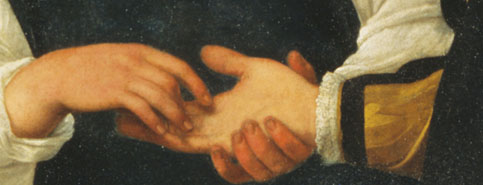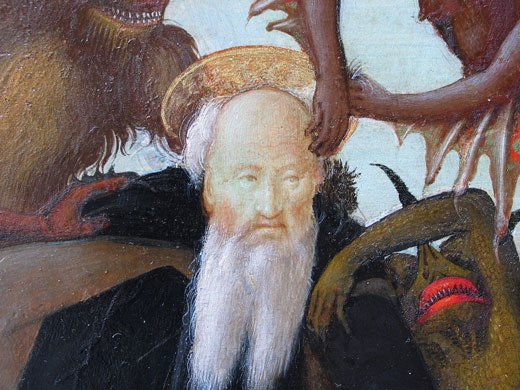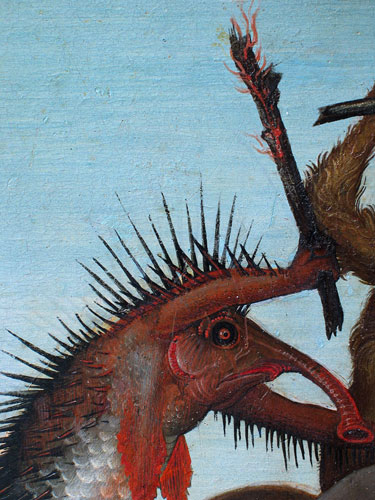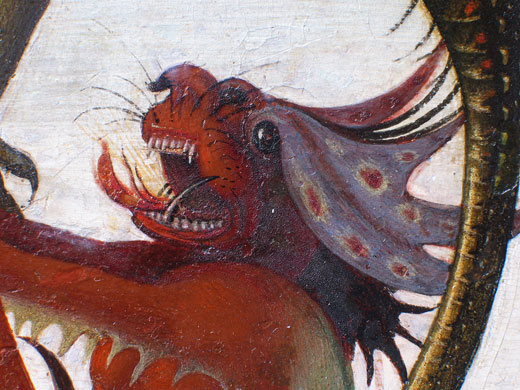Valentin de Boulogne, Soldiers Playing Cards and Dice, c. 1618/20
A magnificent exhibition of Caravaggio and His Followers at the Kimbell Museum in Fort Worth features the Washington National Gallery of Art's Soldiers Playing Cards and Dice by Valentin de Boulogne. The painting tells a story of deception. Caravaggio had also painted Card Sharks with fewer figures. Boulogne, a Frenchman working in Rome, may have known of his composition.
Boulogne's painting is a tight, close-up composition with masterfully chosen areas of light. Two simultaneous episodes are taking place: dice throwing on the right and cheating card players on the left. The card sharks are the first to demand our attention, as they look startlingly real. Behind the central figure, who is in the process of cheating, another drama is happening. A man on the right looks down and covers his dice, perhaps hiding something while his adversary with the red hat seems about to erupt in anger. Although not a traditionally religious painting, Boulogne suggests two of the deadly sins, deception and anger. He warns of the hazards of gambling, exactly what these two vignettes represent.
The sinister scene is set in a dark room. The well-dressed young man in front left is being duped by two soldiers, while two men cross behind them playing dice. The compact composition and the forceful use of diagonals heighten the tension, connecting the men who otherwise would be seen as individual character types. Colors are primarily earthy for these ruffians. But other colors fight for attention: white, scattered touches of blue clothes and the brilliant red hat in center (symbol of anger?), which is replicated in less vibrant red stockings on bottom facing the other
 direction.
direction.A dark, sinister man in the upper left corner startles with his realistic presence. The details of faces come from a blog, Head for Art, May 24, 2010.
 the number two (above). The shadowy compositions suggest that more than cheating is going on, something very dark, sinister and deceptive. Boulogne warns against taking chances in life. Intense light- dark contrast is a legacy of Caravaggio.
the number two (above). The shadowy compositions suggest that more than cheating is going on, something very dark, sinister and deceptive. Boulogne warns against taking chances in life. Intense light- dark contrast is a legacy of Caravaggio.Viewers note the intensity of this soldier's stare and his slow, careful choice of cards pulls the viewer into the story.
Caravaggio, The Fortune Teller, of 1594, comes from the Capitoline Museum of Rome. The aristocratic young man falls in love as he is being duped.
Another allegory of deception Caravaggio painted is The Fortune Teller, 1594, a startlingly realistic depiction in the Kimbell's exhibition. An alluring young gypsy and fashionable aristocrat look at each other with an intense hold. Her face suggests she is attracted to him, or at least feigning an attraction. His puffed sleeve, puffed cheek, elbow, sway of hips and sword express confidence,
 but caution is thrown to the wind. As the girl reads his palm, she slyly slips off his golden ring. The viewer, captivated by the couple's loving gaze and beautiful clothing, is also tricked. We only see this detail by close inspection. The colors are primarily earth tones, black and white.
but caution is thrown to the wind. As the girl reads his palm, she slyly slips off his golden ring. The viewer, captivated by the couple's loving gaze and beautiful clothing, is also tricked. We only see this detail by close inspection. The colors are primarily earth tones, black and white.
The Cheat with the Ace of Clubs, by Georges de la Tour, 1630-34. The cheat, who slyly looks at us and shows his deck, is a "shady" figure, both literally and figuratively. The shadiness of the story is in contrast to the highly polished figures and their clothes.
Georges de la Tour's scene of card players, in the Kimbell's own collection, rounds out these tales of deception. Some elements of The Cheat with the Ace of Clubs are familiar-- its close-up view and dark background. But the colors are brilliant oranges, pinks and reds. The youngest boy will get duped, and everyone else knows they are taking advantage of him. Cheating begins with the large woman who glances sideways at the woman bringing wine, who in turn casts one eye towards the "shady" cardplayer. In shadow on the left, he holds out the cards for us to see and looks at us outside the painting, bringing the viewers into the drama. The boy on right is innocent, but flirting with a world beyond his experience. The background is completely black behind the evil threesome, while the young boy is still halfway "in the light" of the painting, midway between good and bad. He can choose to stay on the right side, both literally and figuratively.
Certain Baroque painters could visually portray situations comparable to the dramatizations of Shakespeare from the 1590s and early 1600s. Carefully calculated figure placements and compositional angles let the human drama unfold before our eyes. They moralize and forewarn viewers of evil. Caravaggio's Fortune Teller and de la Tour's Cheat with the Ace of Clubs also are also comedies, because the well-dressed young men, possibly aristocrats, do not realize their susceptibility to trickery.


















